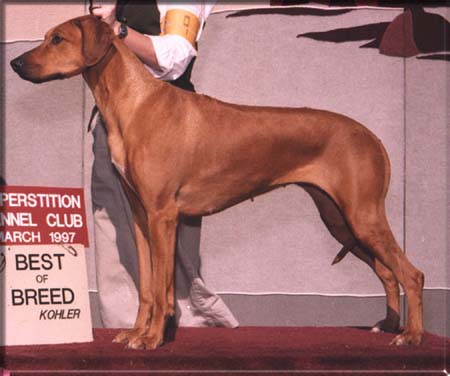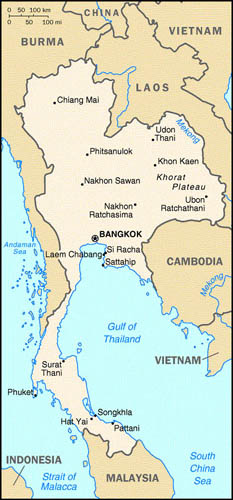back to previous page
Library
The Primitive Ridgeback
By S. Wannakrairoj, Ph. D.
Hundreds of dog breeds world-wide have evolved through natural and/or artificial selection of genetic variances arisen from mutation and hybridization. This selection process is still going on; thus, some breeds are going to disappear unless the breeds have some features that meet the selection criteria. The trait of having hair growing in the opposite direction to the usual coat that appears in only three known breeds is perhaps a major criterion for the selection.
Of the three, the Rhodesian Ridgeback is the artificial breed selected for a ridge from a multi-breed mongrel population. The breed is so well known that its detail will not be further discussed here. Our attention will rather be on the other two breeds that are considered by most people, to be the primitives. The two are the now extinct hound dog of the Hottento tribe of South-West Africa and the Thai Ridgeback Dog of South-East Asia.
The Hottentot Hunting Dog or the Ari Ridgeback dog is better known by most dog-fanciers than the Thailand Ridgeback since the former has been strongly believed to be the ancestor which solely contributed the ridgeback trait to the Rhodesian. As claimed by many, the first record on the Hottentot dog was written by a Dutch man named J. Van Riebeek. Riebeek reached the Cape of Good Hope in April 1652, 133 years after the westward trip around-the-world through South-East Asia of F. Magellan of Portugal, at about the same time as the Hottentot tribe migrated there with their dogs. He described that the domestic dog of the Hottentot had a ridge on its back. However, the recent articles by Dr. Hromnik stated that the Hottentot had been in South Africa long before Riebeek's arrival and nobody ever documented any information about ridged dogs before the 19th century. Since the breed is now extinct, the detailed description of the dog has to be gathered from documents, illustrations and excavation information In a book published in 1857, there is a hunting scene of the Hottentot tribe showing a dog with semi-erect ears, a drop tapered tail and as appeared to many people (but not me), a ridge. Later, a preserved specimen was found and revealed that the Hottentot dog had a ridge, pricked ears, and broad flat skull and a long bushy tail. The two stronger support. In my opinion, we should not rule out that the two types could may well exist in the breed population. This confusion on the Hottentot dog implies its crossbreed status.
From the available historical evidence, all Hottentot dogs had ridges on their backs. In my opinion, as a geneticist, the Hottentot dog must had been thus developed through a careful selection of the ridgeback. The ridgeback trait has never been associated with the ability to survive in nature; therefore, the Hottentot dog with a ridge would have been found along with its non-ridgeback counterpart if the breed was developed solely by natural selection. One also can see that it is difficult to obtain a pure ridgeback population even in the artificially selected population of the Rhodesian. Having many important features of the Dingo/Pariah group, the genetic resource for the selection of the Hottentot dog should be from Asia. This hypothesis agrees with Dr. Hromnik's conclusion.
It is interesting that there is an indigenous breed of Asia that carries a ridgeback. The breed is little known to the western world probably because its country of origin has never been colonized and extensively explored by the western civilization. It is the national dog of Thailand. The breed once was referred to as 'The Phu Quoc Greyhound.' However, its correct name is 'Thai Ridgeback Dog.'

An award winning Rhodesian Ridgeback dog.
Prehistoric people of the late Neolithic period who lived in central Thailand and those of the metal period who lived in North-Eastern Thailand raised dogs as their domestic animal. Archeologist estimated that the dog has been domesticated in Thailand for about 5,300 years. A prehistoric rock art of over 3,0000 years old on a cave wall showing a sickle tail male dog standing by a hunter who was throwing an arrow suggested that the dog was raised to assist in the hunting. Since the dog was so important in the hunting-for-living of the primitive society, the culture of raising a dog must have been a continuous practice for over 5,000 years.
The Thai Ridgeback is believed to be mutated from the original Thai dog (which has almost identical appearance except the ridge), since the Ridgeback has been found intermixed in the natural population of the original breed. Unfortunately, there is no archeological of historical evidence showing when the ridgeback has appeared. All rock art shows just the rough conformation which is similar in both the original and the Ridgeback. Fortunately, the available breeding information suggests that the Thai Ridgeback has mutant dominant alleles of at least 8 (3+5) loci and a mutant recessive allele controlling the ridgeback trait. The breed might breed. This makes the Thailand a one-master dog regardless of the degree of its fierceness.
The Thai dog is a muscular light-medium Pariah, belongs to the Spitz and Primitive Group under FCI classification. It is fearless, upstanding and alert. The wedge-shape head is carried high, has a flat skull for good aerodynamics. Its forehead wrinkles upon its expression of surprise. The stop is well defined but not abrupt. Its well-developed maxillary skeleton and its deep muzzle makes a very powerful bite. It should be noted that the muzzle line must always be straight from the nose tip to the stop. The eyes are dark and almond-shaped. The pricked ears of medium size set on rather low and point slightly outward. The lips are black and tightly closed. Its teeth are of a scissor bite. There is some black marks on the tongue, with exceptional black tongue. The nose is dark with the shoulder height for its static stability and its speed gallop. The wither must be in the same line as its back. The breed has a straight back which either levels or slightly inclines toward the hip. The back is very muscular, but flexible, that produces great galloping, climbing and jumping abilities. The low angularity hind leg also enhances the climbing potential. These attributes are the essential features that the dog needs for its survival in the jungle. However, having the hind legs this way reduces the speed of its gait. A sickle tail with its tip point forward is high set. The tail is tapered and almost reaches its hock. The rather deep-chested body is slightly tucked up with a strong loin. This feature helps the breed to move at a good speed in its gallop. The coat is short, hard, straight and of rather thin undercoat. The modern type may have an ultra-short (so called 'velvet') coat without the under coat. The coat color may be brindle or solid black, red, fawn, beige, blue or white. A small white pattern of not larger than the nose is undesirable, yet permissible. The body skin is slightly tight, thus no dewlap or wrinkles. The edge may be of needle, arrow, violin, harp, brocket or inverted heart (saddle) shape, but has to be of bilateral symmetry. Shoulder height should be 480-61 centimeters (19-24 inches) in dogs and 43-56 centimeters (17-22 Inches) in bitches. The weight should be 19-24 kilograms (42- 53 pounds) in dogs, 17-22 kilograms (37-48 pounds) in bitches.

During the past 20 years, Thai dog breeders have been making an effort to improve the breed. The goal is to add an attacking ability to this hunting hound. Thus the improvement has been emphasized on increasing the height, the weight and the obedience ability. To achieve the goal, the flexibility of movement has to be sacrificed. The jumping and climbing abilities are also thus be the ancestor of the Hottentot dog since the Rhodesian, as a representative of the Hottentot, apparently has less mutant alleles.
This hypothesis agrees with the opinion of renowned historian, Dr. Hromnik. The relationship between the two breeds can be elucidated by the common features of the ridgeback, the crown on the back and also the dermoid cyst desease. Hopefully, a current study conducted by a Dutch research team at Utrecht University on the DNA fingerprint of The Rhodesian, the Phu Quoc and the Thailand will soon provide a solid conclusion on the relationship of the three.
The place of origin of the Thai Ridgeback is another interesting issue since the breed's habitat is not only in Thailand but also in Vietnam, Kamphuchea (Cambodia) and Indonesia. Surprisingly, the dog is found only on the islands of Vietnam, Kamphuchea and Indonesia while it is found on both the islands and the mainland of Thailand. Phu Quoc was the island where the western dog-fancier first encountered the breed and obtained the dog in the 19th century when the island was colonized. A study was undertaken to locate the place where the breed first appeared. To determine the place of origin without any historic record, the genetic analysis of the ridgeback was performed using reported survey data. The width of the ridge and the number of crowns on the body which are controlled by a number of additive alleles were used since the dog with the higher number of mutant alleles has the longer history. According to a genetic theory, the dog with broader ridge or more crowns is resulted from the accumulation of more genes of interest. The Ridgeback in Thailand has its ridge much wider than its back, sometime down to its flank, with the maximum of at least 14 crowns. The closest competitor from Vietnam, including Phu Quoc island, has its ridge only on its back, hardly down to the side, and the maximum of at least 10 crowns. Thus, the Thai dog must have been evolved for the longest period. Hence, the 'Ridgeback' must be of Thai origin. This justified the name 'Thai Ridgeback.' The area with most population of the breed was the eastern fishing ports of Thailand; thus, it was probably a fisherman who took the dog to the islands of Thailand's neighboring countries. The current hypothesis on how the Thai Ridgeback went to South Africa is that Asian traders took the dog with them to Africa in the first millennium AD. To comprehend more about the Thai Ridgeback, on should know its general appearance. The dog is a freedom-loving and active animal. Its brain capability has been developed to be a self-dependent like a human as in other primitive breeds, not a master-dependent like a computer as in the man-made reduced to make a faster gait. This has been done by selecting the higher angularity hind legs and the lower hip than the original. To have a uniform pattern in each coloration, the white pattern is being removed genetically, For a challenge to breeders, the broadest ridge with good bilateral symmetry and well-defined edge is being tried to be produced since it is very difficult to obtain. In addition to the above traits, there some minor features that are being improved; such as, broaden the hock joint while maintaining its short hock. Anyway, there is yet to be a dog that has all these ideal features at this point. The breeder still has to do a lot of work to achieve it.
At the closing of this article everyone must have a better insight about the Thai Ridgeback. One should also be enlightened that the Thai Ridgeback has been the only primitive ridgeback dog in the world. The Hottentot hunting hound was likely to be a primitive cross breed of the Thai dog. Whilst the Phu Quoc dog is simply the same breed as the Thai Ridgeback dog, but named after the place it was first sighted instead of its origin. However, this hypothesis about the primitive ridgeback dog relationship may have some disagreement. All argument with good historical evidence or a better scientific explanation are greatly welcome to with an appreciation.
S. Wannakrairoj, Ph. D.
© Copyright American Thai Ridgeback Association 1995-2018
Notice: Copyright to all photographs displayed on this site is owned by the
photographer.
You may not sell, publish,
license or otherwise distribute any of these photographs without the written
permission of the photographer.
|


